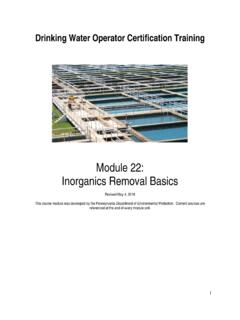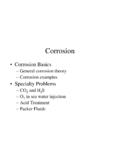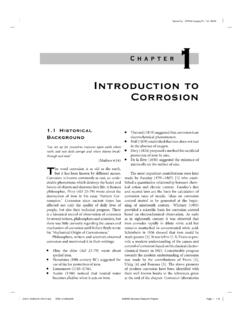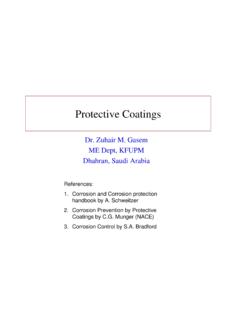Transcription of Water Treatment Basics Course Syllabus
1 Water Treatment Basics Course Syllabus Purpose This Course qualifies as specialized training for the CA and NV Water Treatment operator exams. Topics Basic Water Math Math and Treatment Review Unit Conversions Flow Problems Working with Formulas Chemical Dose Problems Understanding Percentages Source Water Review Calculating Area Reservoirs Review Calculating Volume Reservoir Problems Weight Volume Relationships Coagulation and Flocculation Review Force-Pressure-Head Coagulation and Flocculation Problems Velocity and Flow Rate Sedimentation Review Pumps Sedimentation Problems The Metric System Filtration Review Problem Solving Filtration Problems Disinfection Review Disinfection Problems corrosion control Review Laboratory Problems Regulations Review Treatment Plant Chemicals Management Principles Review Microbiology pH Alkalinity Turbidity Chlorine Total Hardness Ca Hardness CEUs (Contact Hours)
2 Upon completion of this Course you will receive a certificate for CEUs (36 contact hours). Completion Requirements In order to receive IACET CEU credit for this Course , you must complete the following: Complete each individual lesson module by watching the video lecture, completing the lesson handout, and passing the lesson quiz. A score of 70% of higher is required to pass each quiz. Once you have completed all of these elements, your Course completion certificate will be automatically placed into your learning account for printing/downloading. It will remain in your learning account even after your Course access has expired. Learning Objectives Unit Conversions Upon completion of this lesson the student will be able to: Define what a unit is. Define what an equivalent is. Demonstrate how units and equivalents are used to solve math problems.
3 Working with Formulas Upon completion of this lesson the student will be able to: Define what a formula is Demonstrate how a formula is used. Demonstrate how formulas are rearranged Demonstrate how to solve math problems using formulas. Understanding Percentages Upon completion of this lesson the student will be able to: Demonstrate how to convert between fractions and percentages. Demonstrate how to convert between decimals and percentages. Calculating Area Upon completion of this lesson the student will be able to: Demonstrate how to solve for the area of a square Demonstrate how to solve for the area of a rectangle Demonstrate how to solve for the area of a circle Demonstrate how to solve for the area of a triangle Calculating Volume Upon completion of this lesson the student will be able to: Demonstrate how to solve for the volume of a cube Demonstrate how to solve for the volume of a cylinder Demonstrate how to solve for the volume of a cone Demonstrate how to solve for the volume of a sphere Weight/Volume Relationships Upon completion of this lesson the student will be able to.
4 Recall how many pounds one gallon of Water weighs Recall how many gallons are in one cubic foot Recall how many pounds one cubic foot of Water weighs Recall how many liters are in one gallon Recall how many pounds are in one kilogram Discuss and demonstrate how these weight and volume relationships are used to solve math problems. Force-Pressure-Head Upon completion of this lesson the student will be able to: Define force Define pressure Define Water head Recall how many psi (pounds per square inch) is one foot of Water head Discuss and demonstrate how to solve math problems involving force-pressure-head calculations Velocity and Flow Rate Upon completion of this lesson the student will be able to: Define velocity Demonstrate how velocity is calculated Define flow rate Demonstrate how flow rate is calculated Pumps Upon completion of this lesson the student will be able to: Define horse power Define Water horse power Define break horse power Define motor horse power Discuss and demonstrate how to solve pump math problems involving horse power.
5 The Metric System Upon completion of this lesson the student will be able to: Define what metric system units Demonstrate how to convert between weight and volume measurements in the metric system. Demonstrate how to convert between metric units and standard units. Problem Solving Upon completion of this lesson the student will be able to: Define the five steps to problem solving Determine if all five steps are needed to solve a specific problem Explain how the five steps work Apply the five step problem solving method to Water math problems Flow Problems Upon completion of this lesson the student will be able to: Recall the conversion factor between MGD (million gallons per day) and gpm (gallons per minute. Demonstrate how to calculate problems using the MGD to gpm conversion factors Recall the conversion factor between MGD and CFS (Cubic Feet Per Second) Demonstrate how to calculate problems using the MGD to CFS conversion factors.)
6 Chemical Dose Problems Upon completion of this lesson the student will be able to: Describe what units are used in Polymer and Alum Dosing Describe what units are used in chemical feed pump calibrations and settings Explain the jar testing process Demonstrate how to calculate jar testing problems Explain chemical feed system calibrations Demonstrate how to calculate chemical feed calibration problems Demonstrate how to calculate feed pump settings in percent stroke Demonstrate how to calculate chlorinator settings Reservoir Problems Upon completion of this lesson the student will be able to: Describe what units are used in calculating the storage volume of a reservoir Demonstrate how to calculate reservoir storage volume problems Describe what units are used in calculating copper sulfate chemical dose problems Demonstrate how to calculate copper sulfate dosing problems Coagulation and Flocculation Problems Upon completion of this lesson the student will be able to: Demonstrate how to accurately calculate how many pounds of coagulant are used Demonstrate how to accurately calculate the proper dose of a coagulant Demonstrate how to accurately calculate the percent concentration of a stock solution Demonstrate how to accurately calculate percent of coagulant dilution Sedimentation Problems Upon completion of this lesson the student will be able to.
7 Define what sedimentation basins do Demonstrate how to calculate detention time problems Recall what units are used in detention time Demonstrate how to calculate overflow rate problems (surface loading rate problems) Recall what units are used in overflow rate Demonstrate how to calculate flow velocity problems Recall what units are used in flow velocity Demonstrate how to calculate weir loading problems Recall what units are used in weir loading Filtration Problems Upon completion of this lesson the student will be able to: Define what a filter is and what it does Demonstrate how to solve filtration rate problems Demonstrate how to solve level drop rate problems Demonstrate how to solve filter flow rate problems Demonstrate how to solve unit filter run volume (UFRV) problems Demonstrate how to solve backwash flow problems Demonstrate how to solve flow to level increase conversion problems Demonstrate how to solve backwash Water used problems Demonstrate how to solve backwash Water to finished Water percent problems Disinfection Problems Upon completion of this lesson the student will be able to.
8 Define what units and formulas are used in disinfection problems Demonstrate how to solve chlorine dose problems Demonstrate how to solve chlorine demand problems Demonstrate how to solve chlorine usage problems Demonstrate how to solve hypochlorinator flow rate problems Demonstrate how to solve hypochlorite solution strength problems Demonstrate how to solve hypochlorite dilution problems Demonstrate how to solve average pounds per day problems Demonstrate how to calculate chlorine supply in days Laboratory Problems Upon completion of this lesson the student will be able to: Define what units and formulas are used in laboratory problems Demonstrate how to solve temperature conversions between Fahrenheit to Celsius Demonstrate how to solve for the mean and median values of a data set Demonstrate how to solve removal efficiency Source Water Review Upon completion of this lesson the student will be able to: Define source Water vocabulary Discuss proper Water source evaluation Recall the different types of source Water contaminants Explain the hydrologic cycle Distinguish the different types of public Water systems Describe the main objectives of Water Treatment Formulate solutions to Water quality problems Reservoirs Review Upon completion of this lesson the student will be able to.
9 Define reservoir vocabulary Discuss stratification in reservoirs Relate problems with anaerobic conditions Discuss potential problems algae can cause Apply algae control techniques using copper sulfate Coagulation and Flocculation Review Upon completion of this lesson the student will be able to: Define coagulation and flocculation vocabulary words Discuss what is considered Conventional Treatment Express coagulation chemistry Basics Discuss the purpose of flash mixers and define the different types of flash mixers Recall how a Streaming Current Meter operates Discuss the principles of enhanced coagulation Apply jar testing principles Relate what operator actions are taken during changing plant conditions Sedimentation Review Upon completion of this lesson the student will be able to.
10 Define sedimentation vocabulary words Recall the size ranges for various particles Describe the different sedimentation zones Identify the different types of sedimentation basins Analyze the expected performance of the sedimentation process Relate what operator actions are taken during changing plant conditions Filtration Review Upon completion of this lesson the student will be able to: Define filtration vocabulary Recall the factors that affect the filtration process Describe the different filtering mechanisms Identify the different types of filters Describe how filter media is classified Relate the required removal for viruses and Giardia Discuss the instrumentation used to monitor filters Disinfection Review Upon completion of this lesson the student will be able to: Define disinfection vocabulary Recall the factors influencing disinfection Describe the agents of disinfection Identify the properties of chlorine gas Describe the relationship between pH and chlorine species Describe breakpoint chlorination Discuss the pros and cons of alternative disinfectants Relate chlorine safety principles corrosion control Review Upon completion of this lesson the student will be able to: Define corrosion control vocabulary Recall the factors affecting corrosion Describe the tools used to control corrosion Identify the LCR (Lead and Copper Rule) requirements Regulations Review Upon completion of this lesson the student will be able to: Define regulation vocabulary Describe and identify each of the following rules/regulations 1.











